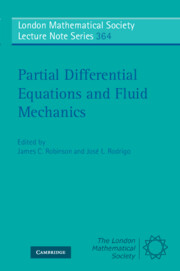Refine search
Actions for selected content:
8126 results in Fluid dynamics and solid mechanics
5 - Lewis Fry Richardson
-
-
- Book:
- A Voyage Through Turbulence
- Published online:
- 07 October 2011
- Print publication:
- 08 September 2011, pp 187-208
-
- Chapter
- Export citation
8 - George Batchelor: the post-war renaissance of research in turbulence
-
-
- Book:
- A Voyage Through Turbulence
- Published online:
- 07 October 2011
- Print publication:
- 08 September 2011, pp 276-304
-
- Chapter
- Export citation
12 - Philip G. Saffman
-
-
- Book:
- A Voyage Through Turbulence
- Published online:
- 07 October 2011
- Print publication:
- 08 September 2011, pp 393-425
-
- Chapter
- Export citation
Preface
-
-
- Book:
- A Voyage Through Turbulence
- Published online:
- 07 October 2011
- Print publication:
- 08 September 2011, pp xi-xvi
-
- Chapter
- Export citation
1 - Osborne Reynolds: a turbulent life
-
-
- Book:
- A Voyage Through Turbulence
- Published online:
- 07 October 2011
- Print publication:
- 08 September 2011, pp 1-39
-
- Chapter
- Export citation
9 - A.A. Townsend
-
-
- Book:
- A Voyage Through Turbulence
- Published online:
- 07 October 2011
- Print publication:
- 08 September 2011, pp 305-328
-
- Chapter
- Export citation
6 - The Russian school
-
-
- Book:
- A Voyage Through Turbulence
- Published online:
- 07 October 2011
- Print publication:
- 08 September 2011, pp 209-237
-
- Chapter
- Export citation

Partial Differential Equations and Fluid Mechanics
-
- Published online:
- 07 September 2011
- Print publication:
- 16 July 2009
ANZ volume 52 issue 2 Cover and Front matter
-
- Journal:
- The ANZIAM Journal / Volume 52 / Issue 2 / October 2010
- Published online by Cambridge University Press:
- 05 September 2011, pp. f1-f2
-
- Article
-
- You have access
- Export citation
ANZ volume 52 issue 2 Cover and Back matter
-
- Journal:
- The ANZIAM Journal / Volume 52 / Issue 2 / October 2010
- Published online by Cambridge University Press:
- 05 September 2011, pp. b1-b4
-
- Article
-
- You have access
- Export citation
EXPLICIT SERIES SOLUTION OF A CLOSURE MODEL FOR THE VON KÁRMÁN–HOWARTH EQUATION
- Part of
-
- Journal:
- The ANZIAM Journal / Volume 52 / Issue 2 / October 2010
- Published online by Cambridge University Press:
- 05 September 2011, pp. 179-202
-
- Article
-
- You have access
- Export citation
RELIABILITY ANALYSIS OF A SIMPLE REPAIRABLE SYSTEM
- Part of
-
- Journal:
- The ANZIAM Journal / Volume 52 / Issue 2 / October 2010
- Published online by Cambridge University Press:
- 05 September 2011, pp. 203-217
-
- Article
-
- You have access
- Export citation
4 - Static Aeroelasticity
-
- Book:
- Introduction to Structural Dynamics and Aeroelasticity
- Published online:
- 05 June 2012
- Print publication:
- 22 August 2011, pp 127-174
-
- Chapter
- Export citation
Figures
-
- Book:
- Introduction to Structural Dynamics and Aeroelasticity
- Published online:
- 05 June 2012
- Print publication:
- 22 August 2011, pp xi-xvi
-
- Chapter
- Export citation
References
-
- Book:
- Introduction to Structural Dynamics and Aeroelasticity
- Published online:
- 05 June 2012
- Print publication:
- 22 August 2011, pp 241-242
-
- Chapter
- Export citation
Tables
-
- Book:
- Introduction to Structural Dynamics and Aeroelasticity
- Published online:
- 05 June 2012
- Print publication:
- 22 August 2011, pp xvii-xviii
-
- Chapter
- Export citation
1 - Introduction
-
- Book:
- Introduction to Structural Dynamics and Aeroelasticity
- Published online:
- 05 June 2012
- Print publication:
- 22 August 2011, pp 1-5
-
- Chapter
- Export citation
3 - Structural Dynamics
-
- Book:
- Introduction to Structural Dynamics and Aeroelasticity
- Published online:
- 05 June 2012
- Print publication:
- 22 August 2011, pp 30-126
-
- Chapter
- Export citation
Foreword
-
-
- Book:
- Introduction to Structural Dynamics and Aeroelasticity
- Published online:
- 05 June 2012
- Print publication:
- 22 August 2011, pp xix-xxii
-
- Chapter
- Export citation
Index
-
- Book:
- Introduction to Structural Dynamics and Aeroelasticity
- Published online:
- 05 June 2012
- Print publication:
- 22 August 2011, pp 243-247
-
- Chapter
- Export citation
